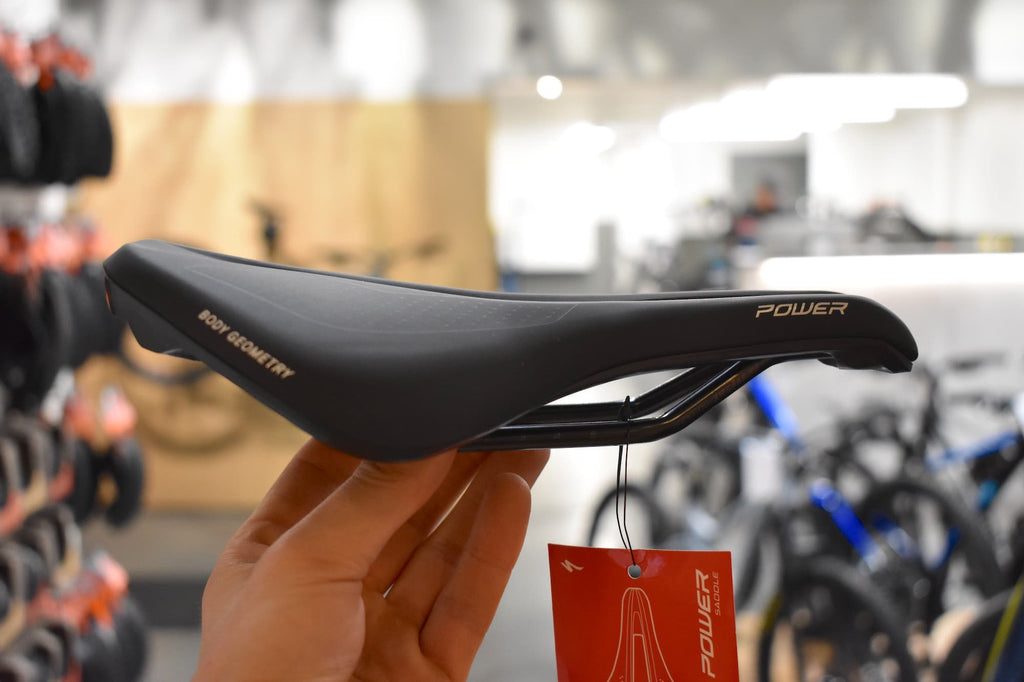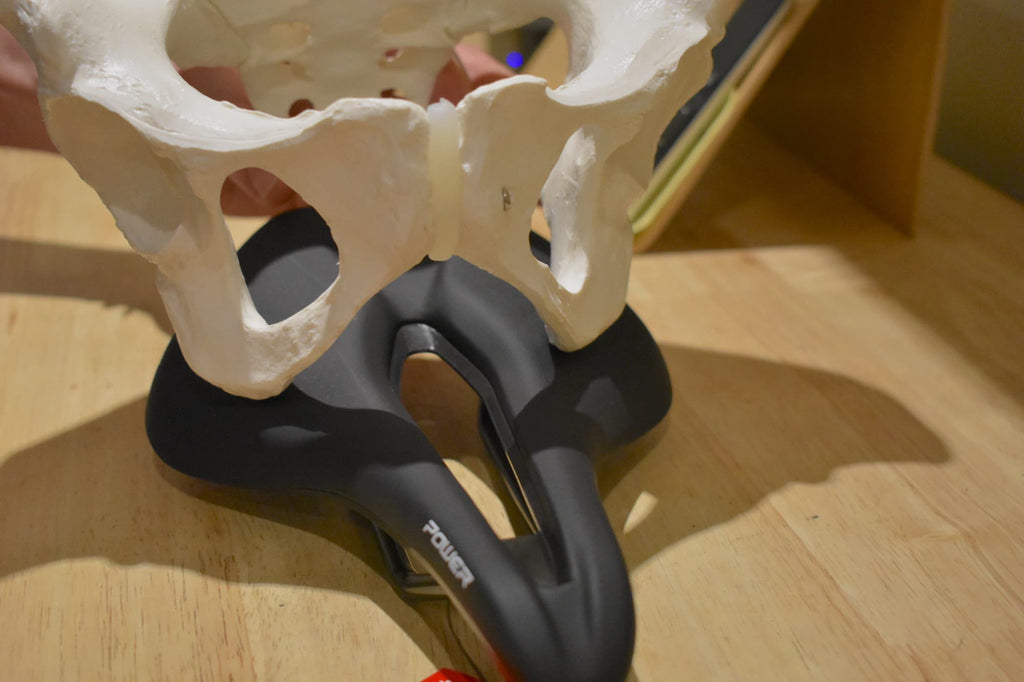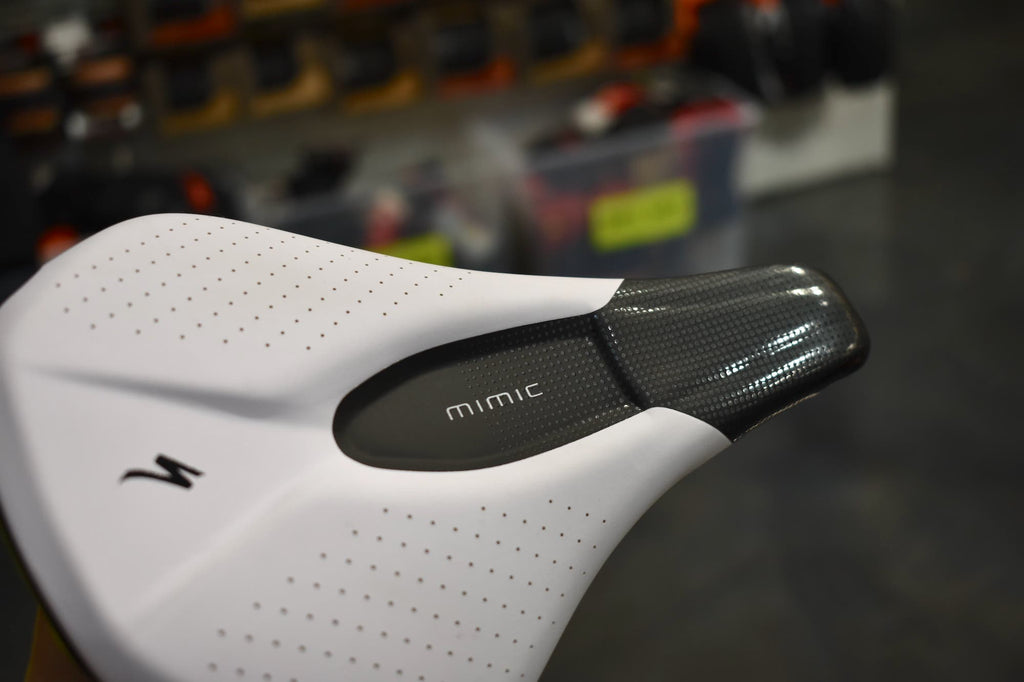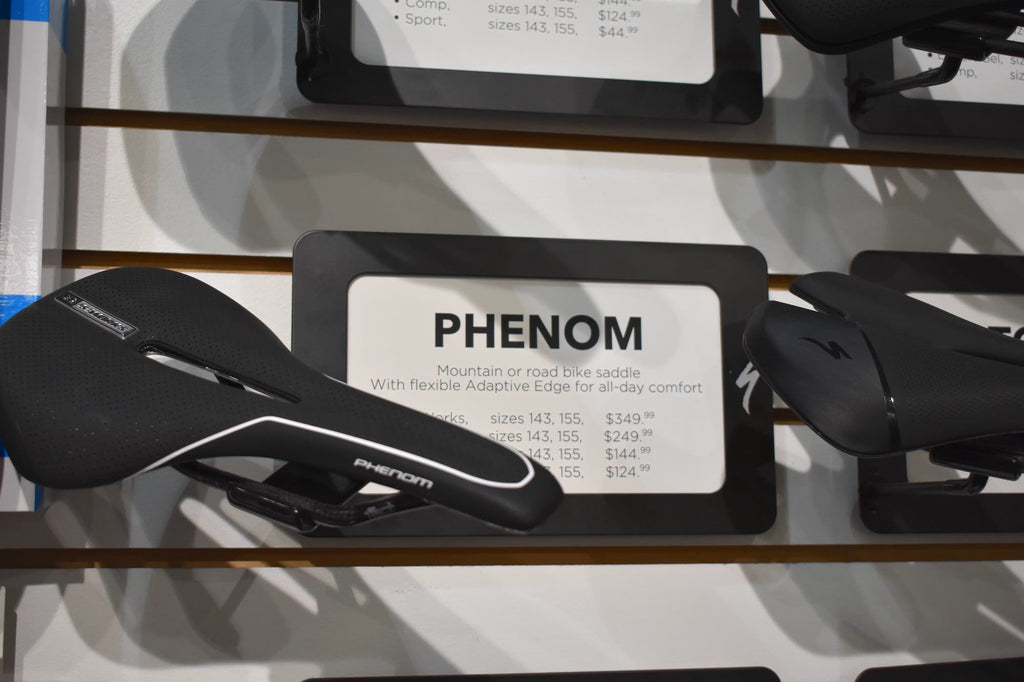The saddle is a part of the bike that, while obviously important, is often overlooked. It's not the most exciting part, and while you're riding you can't even see it. It can be fairly obvious when a saddle is giving you some pain, but many people assume that they just need to get out riding more and toughen up. The reality is that it's one of three contact points on the bike (the others being handlebars and pedals) that are all vitally important that you choose the correct one for yourself, and can be the difference between making a bike feel amazing or awful. I'll be talking more about the other contact points in further articles, but today we focus on your posterior!
 Stock saddles can be good, but they're not right for every rider.
Stock saddles can be good, but they're not right for every rider.
Many people have never had a saddle that works well for them, having only ever stuck with the stock saddle on their bike, which may be too wide, too narrow, have too much or too little padding etc. and just put up with being uncomfortable, chalking it up to being part of the cycling experience. It doesn't have to be this way, and by following our guide below, you too can discover what the right saddle feels like, improving your experience on the bike, riding harder and for longer and changing your riding experience for the better.
I'll be talking here mostly about Specialized saddles, as we feel that they have a great range of well-designed saddles for all riders and cover price points from low to high as well as a range of disciplines and riding styles.
So what should inform your saddle choice?
The ass-o-meter
First off, it's worth talking about Retül's digital sit-bone device (we like to call it the ass-o-meter). It's a super useful tool both for measuring sitbone width and for analysing your riding style in order to suggest the best saddle for you. This tool works with Specialized's catalogue of saddles and asks questions while measuring your sit bones in order to suggest the saddles that might work best for you. We have this tool in store - anyone is welcome to come in and try it out and find out how much difference a comfortable saddle can make!
 Retül's digital sit bone device measures rider's sit bones and suggests compatible saddles accordingly.
Retül's digital sit bone device measures rider's sit bones and suggests compatible saddles accordingly.
Sit Bone Width
The first thing that you should be looking at is saddle width. This is determined by the width of your sit bones or ischial tuberosity to use the scientific term. This is the part of your pelvis that makes contact with the saddle. Different people have different sit bone widths, and it can vary pretty widely. For example, at 6ft1 tall my sit bones measure 101mm apart. Tony at 5ft6 tall measures 140mm. This goes to show that height, build etc. don't necessarily dictate your saddle width.
Getting the right width is important because a saddle is designed around a certain width of sit bone. Get it right and you'll be perfectly positioned and supported on the top of the saddle. Get too narrow a saddle and your sit bones will positioned over the edge of the saddle, and it will feel as though it's trying to cut you in two! It can put pressure on your sensitive parts and cut off blood flow, leaving you feeling numb. It's not a good time. Get too wide a saddle and it can cause chaffing on the insides of your thighs and can cause bruising. So the right width is important.
 The sit bone device also takes into account gender, position on the bike, riding style and other factors.
The sit bone device also takes into account gender, position on the bike, riding style and other factors.
Saddle Shape
Saddle shape is the next consideration, and this is to do with your position on the bike. Riders with a fairly upright position, ie casual riders, riders that tend to sit and spin rather than get low and put the power down down will want a flatter saddle. A more upright rider tends to only have the sit bones contact the saddle, as they are the lowest point of the rider, and so doesn't need much curvature on the saddle, simply support. Most mountain bikers, with the exception of XC racers will probably find that they fit somewhere in the mid-high riding position, and will need a saddle that's fairly flat, depending on how much they like to pedal and how they put their power down.

The Specialized Henge saddle has a fairly long, flat shape.
A rider that has a lower more aggressive position on the bike will want a saddle with more curvature both fore and aft, and left and right. This allows more room and support for the rider's body to contact the saddle as they move down and forwards. A slightly shorter saddle can also be helpful in this case. A rider with this aggressive position with an overly flat saddle may find that they get chaffing on the saddle, and unnecessary pressure in the genitalia resulting in numbness. Something nobody wants! The other benefit of a more curved, shorter saddle is that it can be tilted forward slightly to enable the rider to actually push against it to put down more power.
 The Specialized Power saddle is shorter and has noticeably more curvature to it, perfect for aggressive riders.
The Specialized Power saddle is shorter and has noticeably more curvature to it, perfect for aggressive riders.
The Specialized Power saddle is a great example of a saddle that's short and highly curved, facilitating an aggressive position on the bike, and giving riders something to push back against. Compare this to the Phenom with a fairly long, flat top for riders with a more mid-upright position. The Power saddle works really well for aggressive road riders, and is a fairly popular choice among this crowd.
Padding
Padding is something you will want to think about, and is related to how much you ride and the longevity of the saddle. A saddle with a lot of padding is more suited to a more casual rider. This is because comfort is the main priority to this type of rider - a more padded saddle is more comfortable in the short term, but over a longer ride, where the padding deforms and contacts the areas around the sit bones it can result in chaffing and saddle sores. A saddle with more padding will also pack down, and won't last a frequent/aggressive rider very long, so it can be best for these riders to opt for less padding for the longevity of the saddle.
 Sit bone width is an important consideration, and when the pelvis is rotated further forward, less padding is preferable.
Sit bone width is an important consideration, and when the pelvis is rotated further forward, less padding is preferable.
Mens/womens - cutout or not
Many saddles have a cutout in the centre, to make room for your sensitive parts. For a long time, women's saddles were pretty similar to men's saddles, only wider, as women typically have wider hips. The cutout was not a part that people thought needed to be different, however recent research has shown that blood flows through our sensitive parts differently, and women can experience numbness and swelling much worse than men often do, and so need support in the centre of the cutout to relieve the swelling and improve blood flow. Specialized have achieved this with their Mimic technology. Check out the video below! Specialized make all of their popular saddles with a Mimic women's option, and have a 30-day satisfaction guarantee on their saddles. Many women have never known what it's like to be comfortable on a bike, and Mimic has changed the game for them, we've had none returned yet!
 Specialized's Mimic technology is specifically designed for women, to relieve pressure, aiding blood flow and giving them a more comfortable ride.
Specialized's Mimic technology is specifically designed for women, to relieve pressure, aiding blood flow and giving them a more comfortable ride.
features:
Once you have the all of the above figured out and you've chosen a design of saddle, all that's left really is optional features such as a carbon shell, different rail materials etc. that may make incremental improvements in terms of comfort, for the most part are about saving weight. For example throughout Specialized's range of saddles, the padding and shaping of the saddles remains the same, it is mostly the rails and shell materials that change relative to spec level.
 Specialized's saddles all come with different options with regard to features and spec level, but it doesn't detract from the base comfort and quality.
Specialized's saddles all come with different options with regard to features and spec level, but it doesn't detract from the base comfort and quality.
So there you have it, hopefully this gives you something to think about and will help you to get more comfortable on the bike. Feel free to come in store for a bike fit or just get your sit bones measured, and figure out if the saddle you have now is right for you, or if something could work a little better.











Leave a comment